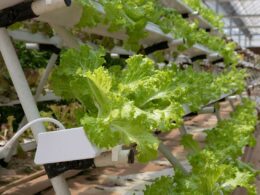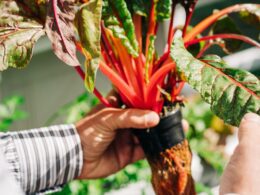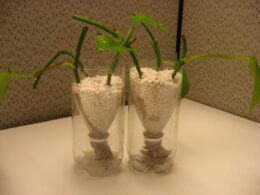Are you curious if your hydroponic system needs to run at night? Many growers wonder about the optimal lighting schedule for their plants, wondering if they need to run their system continuously or if they can give their plants a break during the night. In this article, we will explore the science behind plant growth and the arguments for and against running hydroponics at night, so you can make an informed decision for your grow.
First, let’s dive into the science behind plant growth. Plants need light, nutrients, and water to grow and thrive. In a hydroponic system, plants receive their nutrients and water from a nutrient-rich solution that is circulated around their roots. The light source, whether it be natural or artificial, provides energy for photosynthesis, the process by which plants create their own food.
Understanding how these factors influence plant growth is key to optimizing your hydroponic system. So, let’s explore whether running your hydroponic system at night is necessary for optimal plant growth.
The Science Behind Plant Growth
Understanding how plants grow can help you optimize their growth and ensure a bountiful harvest in your hydroponic gardens. The growth of plants is affected by various factors, including water, nutrients, temperature, and light. These factors work together to ensure that the plant grows and develops properly.
The most important growth factor for plants is light, as it provides the energy needed for photosynthesis. The light spectrum plays a crucial role in plant growth. Plants require different wavelengths of light to grow and develop properly. For example, blue light is essential for plant growth as it helps regulate plant growth hormones and promotes leaf growth. On the other hand, red light is important for flowering and fruiting as it helps trigger the process of photosynthesis.
By understanding the different light spectrums and how they affect plant growth, you can create the ideal conditions for your hydroponic garden. In conclusion, understanding the science behind plant growth is essential for optimizing the growth of plants in your hydroponic garden. By focusing on the different plant growth factors, such as light spectrum, you can create the ideal conditions for your plants to grow and develop.
With the right conditions, you can ensure a bountiful harvest and enjoy the benefits of fresh, healthy produce.
Arguments for Running Hydroponics at Night
You’ll want to run your hydroponic system at night because it’s the best way to maximize growth and yield, giving you the most bountiful harvest possible.
Here are the benefits of running your hydroponics at night:
-
Cooler temperatures: During the day, temperatures can rise and cause stress to your plants. Running your hydroponic system at night will ensure that the temperatures are cooler, creating an optimal environment for plant growth.
-
Reduced evaporation: When the sun is out, the heat can cause water to evaporate quickly, which can lead to water shortages in your hydroponic system. Running your system at night can reduce evaporation, ensuring that your plants have enough water to thrive.
-
Energy savings: Running your hydroponic system at night can help you save on energy costs. By running your system during off-peak hours, you can take advantage of lower electricity rates and reduce your overall energy consumption.
While there are many benefits to running your hydroponics at night, there are also some drawbacks to consider. For example, running your system at night can increase the risk of pests and diseases. Additionally, if you live in an area with high humidity, running your system at night can lead to excess moisture buildup, which can harm your plants.
Overall, running your hydroponic system at night can be highly beneficial for maximizing growth and yield while also saving on energy costs. However, it’s important to weigh the benefits and drawbacks before deciding whether or not to run your system at night. By considering these factors, you can create the best environment for your hydroponic plants to thrive and produce a bountiful harvest.
Arguments Against Running Hydroponics at Night
If you’re wondering whether to run your hydroponics system at night, it’s worth considering the natural growth cycles of plants.
Some argue that plants need periods of darkness to thrive, and that running hydroponics constantly can disrupt this cycle.
Additionally, there are potential negative effects on plant health, such as increased susceptibility to disease and reduced nutrient uptake.
Natural Growth Cycles
Growing plants naturally follow day and night cycles, which can impact their growth and development. This is because plants have their own circadian rhythms that are affected by the amount of light they receive.
Light is essential for photosynthesis, the process where plants turn light energy into chemical energy that they can use to grow. If plants are deprived of light during their natural growth cycle, they can become stressed and may not be able to grow properly.
When it comes to hydroponics, it’s important to understand the natural growth cycles of plants and how they can be affected by light. While it may be tempting to run hydroponics systems at night to save energy costs, this can actually be detrimental to plant growth.
It’s important to provide plants with the proper amount of light during their natural growth cycle to ensure that they are able to grow and develop properly. By understanding the natural growth cycles of plants and providing them with the proper amount of light, you can ensure that your hydroponics system is as effective as possible.
Potential Negative Effects on Plant Health
Now, we need to talk about the potential harm that depriving plants of light can cause. While it’s true that some plants may thrive in darkness, most plants require a certain amount of light to grow properly.
When hydroponic systems run at night, the plants are deprived of the light they need to undergo photosynthesis, which is essential for their growth. This can lead to stunted growth, poor yields, and even plant death.
Moreover, running hydroponic systems at night can cause light pollution and disrupt your sleep. The energy consumption required to keep the systems running at night also adds to the cost of your hydroponic setup.
To avoid these potential negative effects on plant health and your own well-being, it’s best to run your hydroponic system during daylight hours or to use a timer to mimic a natural light cycle. This will ensure that your plants receive the light they need to thrive while also saving you energy and money.
Tips for Optimizing Your Hydroponic Grow
Get the most out of your hydroponic grow by optimizing it with these helpful tips. When it comes to hydroponics, it’s important to remember that every detail counts.
By following these tips, you can ensure your plants are healthy and thriving in your hydroponic system.
-
Adjust your lighting intensity: Too much light can be just as harmful as too little. Make sure you’re providing the right amount of light for your plants by adjusting the intensity based on their needs.
-
Keep a balanced nutrient solution: Your plants need a specific balance of nutrients in order to grow properly. Make sure you’re constantly monitoring and adjusting your nutrient solution to keep it balanced.
-
Maintain proper pH levels: pH levels can greatly affect the health of your plants. Make sure you’re regularly checking and adjusting the pH levels in your hydroponic system to keep them in the optimal range.
By optimizing your hydroponic grow with these tips, you can ensure your plants are healthy and thriving in your system.
Remember to constantly monitor and adjust your lighting intensity, nutrient balance, and pH levels to keep your plants growing at their best.
With a little attention to detail, you can have a successful hydroponic grow.
Conclusion: Finding the Best Lighting Schedule for Your Hydroponic System
You’ll be able to optimize your hydroponic system even further by finding the perfect lighting schedule that best suits your plants’ needs. Lighting intensity is a crucial factor to consider when determining the ideal light schedule. Some plants require higher light intensities to thrive, while others can grow under lower light levels.
You should also take into account the plant species you’re growing and the environmental factors in your growing area. Nutrient uptake is another factor that’s closely tied to lighting schedules. Plants need light to photosynthesize and produce energy, which in turn allows them to take up nutrients from the growing solution.
By providing the right amount and duration of light, you can ensure that your plants are receiving the optimal amount of nutrients from your hydroponic system. In summary, finding the best lighting schedule for your hydroponic system requires careful consideration of several factors, including lighting intensity, plant species, and environmental conditions.
By providing the right amount and duration of light, you can maximize your plants’ growth and nutrient uptake. So take the time to experiment with different lighting schedules and observe how your plants respond. With some trial and error, you’ll be able to find the perfect balance that will help your hydroponic garden thrive.
Frequently Asked Questions
What are some common mistakes to avoid when setting up a hydroponic system?
When setting up a hydroponic system, there are some common mistakes that you should avoid in order to optimize yield and maximize space. One mistake is not properly sterilizing your equipment, which can lead to the growth of harmful bacteria and fungi.
Another mistake is not monitoring the pH levels of your nutrient solution, which can cause nutrient deficiencies and stunted growth. To troubleshoot these issues, make sure to regularly clean and sterilize your equipment, and test your nutrient solution for proper pH levels.
Additionally, make sure to properly space out your plants and provide enough light and nutrients for healthy growth. By avoiding these common mistakes and following these troubleshooting tips, you can ensure a successful hydroponic setup and a bountiful harvest.
How does the type of lighting used affect plant growth in hydroponics?
To optimize plant growth in hydroponics, it’s important to pay attention to the type of lighting used. Light spectrum and intensity play crucial roles in plant morphology and nutrient uptake.
Different light spectrums can affect plant growth in various ways, such as promoting leafy growth or encouraging fruiting. Meanwhile, light intensity affects how much energy plants can absorb from the light, which directly impacts nutrient uptake.
To ensure the healthiest growth for your hydroponic plants, it’s important to choose the right type of lighting and adjust it as needed to provide the ideal spectrum and intensity.
What are some alternative ways to provide plants with the nutrients they need in hydroponics?
Looking for alternative ways to provide your plants with the nutrients they need in hydroponics?
Vertical farming and nutrient film technique are both great options. With vertical farming, you can stack your plants vertically to maximize space and growing potential.
Nutrient film technique involves a continuous flow of nutrient-rich water over the roots of your plants, ensuring they have access to the nutrients they need at all times. These methods are simple, effective, and can help you grow healthier, more robust plants without the need for traditional soil-based methods.
So if you’re looking for a new way to grow your plants, consider giving vertical farming or nutrient film technique a try!
Can hydroponic systems be used to grow plants outside of the typical growing season?
Looking to keep your garden growing even when the weather outside is frightful? Year-round farming is possible thanks to hydroponics – a method of growing plants without soil.
Controlled environment agriculture allows you to create an optimal environment for your plants, regardless of the season. By providing the perfect temperature, humidity, and light, you can grow your favorite fruits and vegetables indoors or outdoors, all year long.
With hydroponics, you can say goodbye to the limitations of traditional soil-based gardening and hello to fresh produce whenever you want it.
How does the pH level of the nutrient solution impact plant growth in hydroponics?
To ensure optimal plant growth in hydroponics, it’s important to maintain the right pH levels in the nutrient solution. The optimal pH range is between 5.5 and 6.5, which allows for efficient nutrient uptake by the plants. If the pH balance is off, it can lead to nutrient deficiencies and ultimately hinder plant growth.
A pH imbalance can occur if the nutrient solution becomes too acidic or too alkaline. Regularly monitoring and adjusting the pH levels can prevent this from happening. So, it’s crucial to keep a close eye on the pH levels of your nutrient solution to ensure healthy and thriving plants in your hydroponic system.
Conclusion
So, do hydroponics need to run at night? It ultimately depends on your specific setup and the type of plants you’re growing. While some argue that running hydroponics at night can promote plant growth and save on energy costs, others believe that it can disrupt the natural circadian rhythm of the plants and cause stress.
To optimize your hydroponic grow, consider experimenting with different lighting schedules and monitoring the growth and health of your plants. Keep in mind the specific needs of your plants and adjust accordingly.
With proper care and attention, your hydroponic system can thrive and produce healthy, bountiful harvests.









